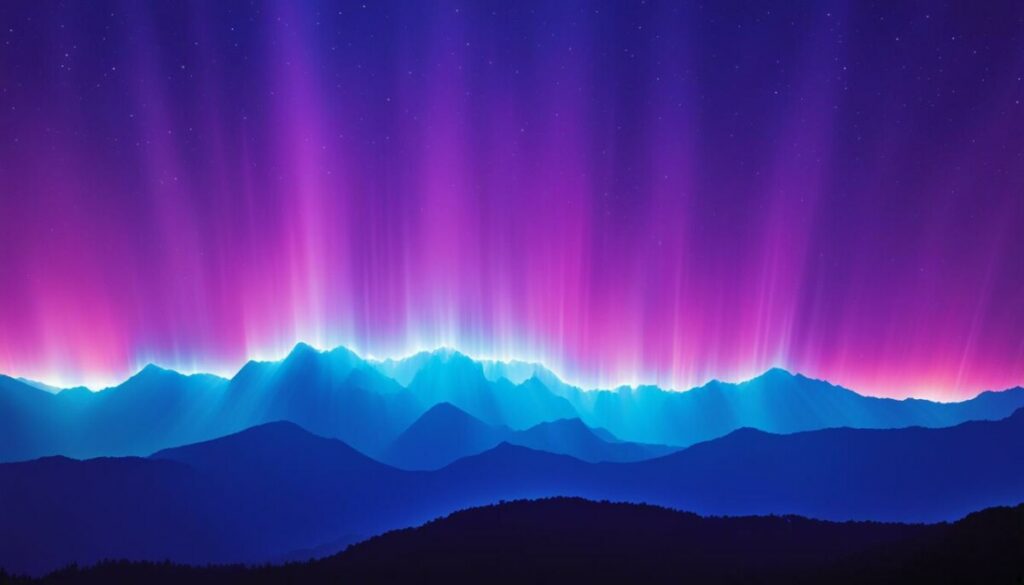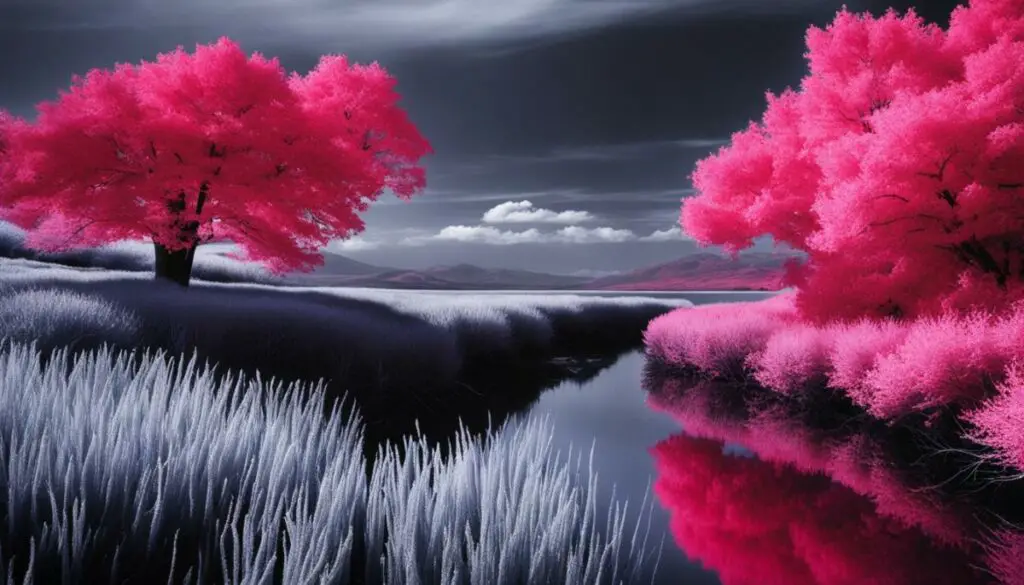Last Updated on 4 months by Francis
When it comes to energy levels, two forms of light stand out: ultraviolet (UV) and infrared (IR). These two types of electromagnetic radiation occupy opposite ends of the spectrum, with UV carrying higher energy and shorter wavelengths than IR. Understanding the differences between UV and IR energy can shed light on their applications and potential risks.
Contents
Key Takeaways:
- UV light has shorter wavelengths and carries more energy than visible light.
- IR light has longer wavelengths and carries less energy than visible light.
- Both UV and IR fall within the electromagnetic spectrum.
- UV radiation has various applications, but it also presents hazards to the eyes and skin.
- IR radiation is widely used in heating and cooling, with fewer associated risks.
Understanding Electromagnetic Radiation

Electromagnetic radiation encompasses the energy produced by the oscillation or acceleration of charged particles. Light, a type of electromagnetic radiation, can be described as both waves and particles called photons. The intensity of light is directly proportional to the number of photons emitted.
The electromagnetic spectrum ranges from gamma rays, which have the highest energy, to radio waves, which have the lowest energy. Within this spectrum, ultraviolet (UV) and infrared (IR) light find their place.
“Light can be both a wave and a particle, making it a fascinating form of electromagnetic radiation.”
Photons, the particles of light, carry energy and have specific wavelengths. The wavelength represents the distance between two corresponding points on adjacent waves, such as wave crests. UV light has shorter wavelengths than visible light, while IR light has longer wavelengths. UV light carries higher energy levels compared to IR light.
| Electromagnetic Spectrum | Wavelength Range | Energy Level (increasing) |
|---|---|---|
| Gamma Rays | Less than 0.01 nm | High |
| X-Rays | 0.01 nm – 10 nm | |
| Ultraviolet | 10 nm – 380 nm | |
| Visible Light | 380 nm – 750 nm | |
| Infrared | 750 nm – 1 mm | Low |
| Microwaves | 1 mm – 1 m | |
| Radio Waves | More than 1 m | Lowest |
“The electromagnetic spectrum covers a wide range of wavelengths and energy levels, with each segment having its own characteristics and applications.”
- Gamma rays: Used in cancer treatment, sterilization, and nuclear medicine.
- X-rays: Used in medical imaging, security scanning, and materials analysis.
- Ultraviolet: Used in sterilization, fluorescence, and tanning.
- Visible light: Allows us to perceive the world around us and is essential for photosynthesis.
- Infrared: Used in heating, remote controls, and thermal imaging.
- Microwaves: Utilized for cooking, communication, and weather forecasting.
- Radio waves: Used in broadcasting, communication, and radar systems.
Understanding the nature of electromagnetic radiation and its various segments, including UV and IR light, is crucial for comprehending how they interact with the environment and their respective applications in different fields.
UV vs. IR in the Electromagnetic Spectrum

When it comes to the electromagnetic spectrum, visible light occupies a small range of wavelengths, specifically from 380 nm to 750 nm. Ultraviolet (UV) radiation, on the other hand, falls in the range of shorter wavelengths, ranging from 10 nm to 380 nm. UV light carries more energy than visible light, making it a significant part of the spectrum.
Conversely, infrared (IR) radiation encompasses longer wavelengths, extending from 750 nm to 1 mm. Compared to visible light, infrared radiation carries less energy. This distinction in wavelength and energy levels between UV and IR is crucial in understanding how they function within the electromagnetic spectrum.
With its shorter wavelengths, UV radiation is known for its higher energy output compared to visible light. This makes UV radiation more potent and capable of causing various effects, both positive and negative, on the environment and living organisms.
On the other hand, infrared radiation, with its longer wavelengths, carries less energy than visible light. While it may not possess the high-energy impact of UV radiation, infrared radiation plays a vital role in heat transfer and has numerous practical applications.
The Subdivisions of UV Radiation

UV radiation, a component of sunlight, can be classified into three subdivisions based on their wavelengths: UVA, UVB, and UVC.
The subdivision UVA refers to ultraviolet A radiation, which has wavelengths ranging from 315 nm to 400 nm. It is the most abundant form of UV radiation that reaches the Earth’s surface.
UVB, or ultraviolet B radiation, has shorter wavelengths ranging from 280 nm to 315 nm. This type of radiation is responsible for causing sunburns and is partially absorbed by the Earth’s atmosphere.
Lastly, UVC, or ultraviolet C radiation, has the shortest wavelengths ranging from 100 nm to 280 nm. However, the majority of UVC radiation is filtered out by the Earth’s atmosphere, and very little reaches the surface.
It’s worth noting that the most high-energy UV radiation, with wavelengths below 290 nm, is almost entirely absorbed by the Earth’s atmosphere before it reaches us.
“The subdivision of UV radiation into UVA, UVB, and UVC enables us to better understand the different effects and risks associated with each type. By studying their specific wavelengths, we can develop targeted protection measures against the harmful effects of UV radiation.”
How Infrared Heat Works

Infrared heat, generated through radiation, is a powerful form of heat transfer that operates without the need for physical contact. The process begins when infrared rays from an infrared heater come into contact with various objects within the room, such as walls, ceilings, or floors. It is this contact that triggers a remarkable reaction within the molecules of these objects, setting them into motion and causing them to oscillate rapidly. This molecular oscillation, in turn, generates heat, which spreads throughout the room and warms the surroundings.
One exciting aspect of this heat transfer mechanism is that it affects not just the objects in direct contact with the infrared rays, but also all other objects in the room. This phenomenon occurs due to the emission of heat by those objects whose molecules have been set into motion by the infrared rays. As a result, the entire room becomes a network of heat emitters, ensuring an even distribution of warmth and creating a cozy and comfortable environment.
This process of heat generation through molecular oscillation distinguishes infrared heat from other conventional methods of heat transfer, such as conduction and convection. While conduction involves the transfer of heat through direct physical contact, and convection relies on the movement of hot air, infrared radiation transcends these limitations, reaching all corners of a room and providing efficient and effective heating.
To illustrate how infrared heat works, consider the following diagram:
| Heat Transfer Mechanism | Description |
|---|---|
| Conduction | Heat transfer through direct physical contact. |
| Convection | Heat transfer through the movement of hot air. |
| Radiation | Heat transfer through the emission of infrared rays. |
As seen in the table above, infrared radiation stands out as a unique and effective method of heat transfer, affording numerous benefits in terms of energy efficiency and overall comfort. By harnessing the power of molecular oscillation, infrared heaters provide efficient and even heating, transforming any space into a warm and cozy environment.
The Applications of UV and IR

UV and IR have various applications in different fields. UV is commonly used in night vision technology, tracking systems, heating and cooling, communication devices, meteorology, and astronomy. IR, on the other hand, finds applications in photography, electrical systems, analytics, material science, heating, and cooling.
UV radiation plays a crucial role in night vision technology, enabling devices to capture and amplify visible and near-infrared light to enhance visibility in low-light conditions. This technology is utilized by law enforcement agencies, military personnel, and security professionals for surveillance and target acquisition.
Tracking systems, both civilian and military, make use of UV light to monitor and trace objects or targets. UV sensors detect fluorescent markers or specialized UV-reflective materials to track movement and provide invaluable data in various applications, such as wildlife tracking, industrial automation, and sporting events.
The heating and cooling industry also benefits from UV radiation. UV lamps installed within HVAC systems help to eliminate harmful bacteria, mold, and allergens, improving indoor air quality and reducing the risk of respiratory-related issues. Furthermore, UV radiation is used in the sterilization process of medical equipment and water purification systems.
In the realm of communications, UV light finds applications in optical fibers and telecommunications systems. The high-frequency nature of UV radiation allows for faster data transmission and a higher bandwidth compared to other wavelengths, making it an essential component in high-speed internet connections and long-distance communication networks.
Meteorologists rely on UV measurements to study atmospheric conditions and understand the impact of UV radiation on weather patterns. UV radiation data is crucial for predicting ozone depletion, evaluating climate change parameters, and studying the effects of solar radiation on the Earth’s surface.
Astronomers utilize UV light to observe celestial objects and phenomena that emit UV radiation. Specialized telescopes and instruments are designed to capture UV wavelengths, allowing scientists to study the composition, temperature, and dynamics of stars, galaxies, and interstellar clouds.
In the realm of photography, IR radiation is widely used to capture unique and creatively appealing images. Infrared photography involves using filters that block visible light and only allow IR light to reach the camera sensor, resulting in ethereal landscapes, dreamlike portraits, and stunning black-and-white imagery.
Electrical systems greatly benefit from IR radiation. Thermal imaging cameras, which use IR sensors, provide invaluable insights into electrical faults, heat distribution, and insulation issues. This allows technicians and engineers to identify problems early on, preventing potential equipment failure or fire hazards.
Analytics and material science also leverage IR technology as it enables non-destructive testing and quality control. IR spectroscopy is commonly used to analyze the chemical composition of materials, identify unknown substances, and assess the structural integrity of various products and components.
Hazards of UV and IR

While both UV radiation and IR radiation pose risks, UV radiation presents more hazards compared to IR radiation. UV radiation has the potential to cause significant damage to the eyes and skin, increasing the risk of developing conditions such as malignant melanoma, a type of skin cancer.
UV radiation, particularly from prolonged exposure to the sun or tanning beds, can lead to eye damage. The eyes are sensitive to UV radiation and prolonged exposure without adequate protection, such as sunglasses or UV-blocking contact lenses, can result in various eye conditions. These include photokeratitis, or “sunburn of the eye,” which causes temporary vision loss, blurred vision, and extreme sensitivity to light. Furthermore, long-term exposure to UV radiation can contribute to the development of cataracts, a clouding of the eye’s lens that can lead to vision impairment or even blindness if left untreated.
UV radiation can also cause significant damage to the skin. Overexposure to UV radiation can lead to sunburn, premature aging, and an increased risk of developing skin cancer, including malignant melanoma. Malignant melanoma is a potentially life-threatening form of skin cancer that develops in the cells responsible for producing pigment in the skin. It is crucial to protect the skin from UV radiation by regularly applying sunscreen with a high SPF, seeking shade during peak sunlight hours, and wearing protective clothing, such as hats and long-sleeved shirts.
While IR radiation generally poses fewer risks than UV radiation, exposure to high amounts of IR radiation can be hazardous, especially to the eyes. Direct and prolonged exposure to intense sources of IR radiation, such as welding arcs or certain industrial processes, can cause thermal damage to the eyes. This can result in peripheral vision loss, cataracts, and other eye conditions.
In summary, UV radiation carries higher risks in terms of eye damage, skin damage, and the development of malignant melanoma. However, it is important to exercise caution and protect oneself from both UV and IR radiation to minimize potential hazards.
| UV Radiation | IR Radiation | |
|---|---|---|
| Hazards | Eye Damage, Skin Damage, Malignant Melanoma | Eye Damage |
| Effects | Eye conditions (photokeratitis, cataracts), Sunburn, Premature aging, Skin cancer (malignant melanoma) | Peripheral vision loss, Cataracts, Other eye conditions |
| Protection Measures | Sunglasses, UV-blocking contact lenses, Sunscreen, Protective clothing | Limit exposure, Protective eyewear |
Infrared vs. Ultraviolet: A Side-by-Side Comparison

A comparison between infrared and ultraviolet reveals several differences. Infrared, discovered by William Herschel in 1800, and ultraviolet, discovered by Johann Wilhelm Ritter in 1801, both belong to the electromagnetic spectrum but have distinct characteristics.
| Infrared | Ultraviolet |
|---|---|
| Frequencies | Frequencies |
| Ranging from 300 GHz to 400 THz | Ranging from 800 THz to 30 PHz |
| Wavelengths | Wavelengths |
| Ranging from 780 nm to 1 mm | Ranging from 400 nm to 180 nm |
| Energy Levels | Energy Levels |
| Ranging from 1.2 meV to 1.7 eV | Ranging from 3 eV to 124 eV |
Both infrared and ultraviolet have various applications. Infrared is commonly used in thermal imaging, heating and cooling systems, and everyday household devices. It is also utilized in surveillance cameras and remote controls. Ultraviolet finds applications in fluorescent lighting, imaging techniques, such as UV photography, and certain skin treatments, like phototherapy.
However, it is crucial to recognize that both infrared and ultraviolet come with possible hazards. Ultraviolet radiation can cause damage to the eyes and skin, including the development of malignant melanoma, a type of skin cancer. Infrared radiation, when exposed in high amounts, can also pose risks, particularly to the eyes.
To summarize, while infrared and ultraviolet possess distinct frequencies, wavelengths, and energy levels, they both have a wide range of applications. However, it is essential to exercise caution and mitigate potential hazards associated with their exposure.
The Origins and Spectrums of Infrared and Ultraviolet
Infrared radiation, also known as IR, was discovered by William Herschel in 1800. While conducting experiments with thermometers, Herschel noticed heat sources beyond the visible range of light. This led to the understanding of infrared as a form of energy that extends beyond what the human eye can perceive. Infrared spans wavelengths from 780 nm to 1 mm, falling in the low-frequency end of the electromagnetic spectrum.
On the other hand, ultraviolet radiation, commonly referred to as UV, was discovered by Johann Wilhelm Ritter in 1801. While experimenting with various light sources, Ritter observed effects beyond the violet light. This discovery marked the identification of ultraviolet as a unique form of electromagnetic radiation. Ultraviolet spans wavelengths from 400 nm to 180 nm, positioning it between visible light and X-rays on the electromagnetic spectrum.
Comparing the Spectrums:
| Infrared | Ultraviolet |
|---|---|
| Wavelength Range: 780 nm to 1 mm | Wavelength Range: 400 nm to 180 nm |
| Falls in the low-frequency end | Positioned between visible light and X-rays |
| Carries less energy compared to visible light | Carries more energy compared to visible light |
As seen from the comparison above, infrared and ultraviolet have distinct spectrums with different wavelength ranges. Infrared lies beyond the red end of the visible light spectrum and is associated with longer wavelengths, while ultraviolet lies beyond the violet end and has shorter wavelengths. Additionally, ultraviolet carries more energy compared to visible light, while infrared carries less energy.
“The discovery of infrared and ultraviolet radiation revolutionized our understanding of the electromagnetic spectrum, broadening our knowledge about the diverse forms of energy that exist beyond the visible range of light.” – William Herschel
Infrared vs. Ultraviolet: Which One Is Better?
When comparing infrared and ultraviolet, it’s important to consider their applications, hazards, benefits, and weaknesses. Infrared is widely used in thermal imaging, heating and cooling, and everyday household devices. Ultraviolet, on the other hand, has limited applications but finds use in fluorescent lighting, imaging, and certain skin treatments. Let’s explore the applications, hazards, benefits, and weaknesses of both infrared and ultraviolet.
Applications
Infrared:
- Thermal imaging
- Heating and cooling
- Everyday household devices
Ultraviolet:
- Fluorescent lighting
- Imaging
- Certain skin treatments
Hazards
Infrared:
Infrared radiation poses fewer hazards compared to ultraviolet radiation.
Ultraviolet:
Ultraviolet radiation carries more hazards, including damage to the eyes and skin.
Benefits
Infrared:
Infrared radiation provides efficient heat transfer, making it suitable for various heating applications. It also enables thermal imaging, which helps detect heat signatures and identify potential issues in different industries.
Ultraviolet:
Ultraviolet radiation plays a role in fluorescent lighting, allowing for energy-efficient illumination. It also has applications in medical imaging and certain skin treatments, such as psoriasis therapy.
Weaknesses
Infrared:
One weakness of infrared radiation is that its heat transfer can be affected by obstacles and distance.
Ultraviolet:
One weakness of ultraviolet radiation is its potential to cause harm, such as eye damage and skin burns, when exposure is not properly managed.
| Infrared | Ultraviolet | |
|---|---|---|
| Applications | Thermal imaging, heating and cooling, everyday household devices | Fluorescent lighting, imaging, certain skin treatments |
| Hazards | Fewer risks | Potential eye and skin damage |
| Benefits | Efficient heat transfer, thermal imaging | Energy-efficient lighting, medical imaging, skin treatments |
| Weaknesses | Affected by obstacles and distance | Potential harm when not properly managed |
Based on their applications, hazards, benefits, and weaknesses, both infrared and ultraviolet have their own unique characteristics. Infrared radiation is widely used for heat transfer and thermal imaging, while ultraviolet radiation has niche applications in lighting and medical fields. It’s crucial to understand the associated risks and take precautions when working with these types of radiation.
Conclusion
In conclusion, the comparison between ultraviolet (UV) and infrared (IR) light reveals interesting differences in their energy levels and applications within the electromagnetic spectrum. UV light, with its shorter wavelengths and higher energy levels, has a wide range of applications in fields such as night vision technology, tracking systems, heating and cooling, communications, meteorology, and astronomy. However, UV radiation also poses hazards, particularly to the eyes and skin, including the risk of malignant melanoma.
On the other hand, IR light, with its longer wavelengths and lower energy levels, finds extensive use in heating and cooling applications, as well as in thermal imaging and everyday household devices. IR radiation carries fewer risks compared to UV radiation, making it a safer option for various scenarios.
Understanding the characteristics and differences between UV and IR is essential to grasp their roles within the electromagnetic spectrum. While UV light demonstrates higher energy levels and shorter wavelengths, IR light offers versatility and a lower risk profile. It is important to consider both the benefits and hazards associated with UV and IR in order to make informed decisions regarding their use and protection against potential dangers.
FAQ
What is the difference between ultraviolet (UV) and infrared (IR) light?
UV light has shorter wavelengths and carries more energy than visible light, while IR light has longer wavelengths and carries less energy.
How do UV and IR light compare in terms of energy levels?
UV light carries higher energy levels compared to IR light.
How do UV and IR light fit into the electromagnetic spectrum?
UV light falls on the higher energy end of the electromagnetic spectrum, while IR light falls on the lower energy end.
What are the applications of UV and IR light?
UV light is used in night vision technology, tracking systems, heating and cooling, communication devices, meteorology, and astronomy. IR light finds applications in photography, electrical systems, analytics, material science, heating, and cooling.
What are the hazards associated with UV and IR light?
UV light can cause damage to the eyes and skin, including the development of malignant melanoma. IR light, when exposed in high amounts, can also pose risks, particularly to the eyes.
How do infrared heaters work?
Infrared heaters emit infrared rays that come into contact with objects, causing the molecules in those objects to oscillate and generate heat, resulting in infrared heat.
What are the subdivisions of UV radiation?
UV radiation is divided into UVA, UVB, and UVC based on their wavelengths. UVA ranges from 315 nm to 400 nm, UVB ranges from 280 nm to 315 nm, and UVC ranges from 100 nm to 280 nm.
How do infrared and ultraviolet compare in terms of wavelengths and frequencies?
Infrared light has wavelengths ranging from 780 nm to 1 mm, while ultraviolet light has wavelengths ranging from 400 nm to 180 nm. Infrared has frequencies ranging from 300 GHz to 400 THz, while ultraviolet has frequencies ranging from 800 THz to 30 PHz.
What are the origins and discoveries of infrared and ultraviolet?
Infrared light was discovered by William Herschel in 1800, while ultraviolet light was discovered by Johann Wilhelm Ritter in 1801. Herschel noticed heat sources beyond the visible range of light, while Ritter observed the effects of light beyond violet light.
Which is better, infrared or ultraviolet?
The choice between infrared and ultraviolet depends on their specific applications, as well as the associated hazards, benefits, and weaknesses. It is important to consider these factors when determining which is more suitable for a particular use.





.jpg)


